Fantastic birding in Extremadura
Fantastic birding in Extremadura
To make a change from our usual blogs, we thought we'd share with you an extract from our original manuscript for The Biggest Twitch book. Here we've written about the incredible birding we enjoyed in just our first day in Extremadura in 2008. This really is a spectacular part of Spain and we can't wait to get back there again in March 2013 for more extremely good Extremadura birdwatching!
We reached Trujillo in good time and quickly found our accommodation just south of the town. We had booked into a small family-run place called Casa Rural El Recuerdo. A lovely place, an old farm converted into beautiful accommodation retaining the historic features such as the vaulted ceilings and a roaring log fire, it was a perfect base for our birding. Martin and Claudia Kelsey run the Casa and provided a really warm welcome and more importantly, it was soon obvious that Martin was a good birder with a wealth of local knowledge. 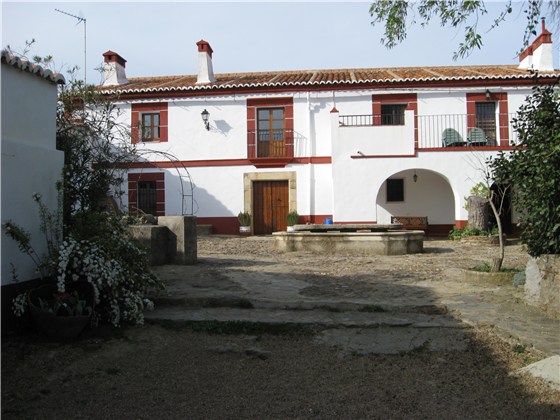
Cosy accommodation with Martin and Claudia
We enjoyed a welcome drink and then headed out to find some birds in what little light remained. Even before we were out of the tiny village, we added the spectacular Azure-winged Magpie to our year list. We then headed into Trujillo and made straight for the bullring, a site I knew had birds we needed. It’s perhaps not the most obvious place to begin our birding but the semi-derelict roof of the bullring makes an ideal nesting spot for Lesser Kestrels. We only had to wait a minute or so before one flew in and landed on the broken red tiled roof. A lovely male with powder-grey head and chestnut mantle, he sat and peered down at us, unafraid, and we soaked up the views. Raucous calls drew our attention to another new bird. A party of Spotless Starlings had landed on nearby television aerials and were calling as more birds flew in to join them. Glossy purple-black in the last of the evening sun, these wild-crested birds flew onto the roof and climbed inside for the night. We called it a day too and headed back, but as we did, a gorgeous Red Kite soared low over the road. What a stunning bird, surely one of the best raptors anywhere in the world? The fox-red tail showed off wonderfully in the dying glow of the sunset, a fitting end to a long day. We felt we were in for a great time in Spain. 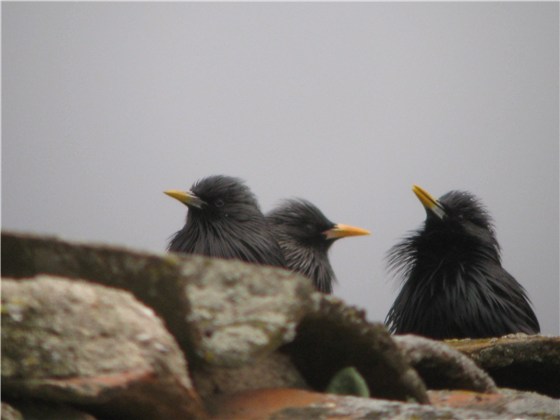
Spotless Starlings enjoying the roof!
Back at the Casa, Martin and Claudia looked after us very well; drinks were followed by a lovely meal featuring vegetables from their own garden. Martin looked over our wish list of Spanish birds and was sure we could find most of them with his expert knowledge. The map was spread out and we talked birds. The next morning we drove west from Trujillo in the dark and took a narrow road north. On reaching a dirt track off to our right, we parked and waited for the first signs of dawn. It was cold, surprisingly cold and we left the car heater running for a while. As the first glimmers of light crept across the vast eastern horizon, we killed the engine and immediately heard birdsong. Skylarks were belting out sweet music across the vast rolling grass plain. The sound made the hair on the back of our necks stand on end with excited anticipation of the birding to come. This was a wild big place with undulating tilled fields stretched out in all directions like a rucked-up carpet. This place was full of birds and we had it all to ourselves to explore, just the two of us and the larks under a vast sky amongst carpets of glorious wild flowers.
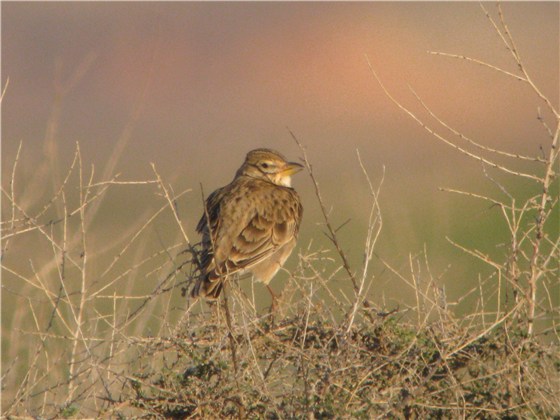
Calandra Lark - target bird
Stepping from our cocoon of warmth, we were hit by the chill of the dawn air and a biting wind, and we wished we had put on more clothes. A bird flew from the ground, flapping fast and rising almost vertically into the cold air, the black under-wing with white trailing edge gave away the identity, a Calandra Lark. A big cousin of the familiar Skylarks, this was new for our list and we watched spellbound as it rose in front of us singing at full volume. As the light improved, we began to see many Calandra Larks flying low over the grassland then pitching into the flowers, where only an inquisitive head could be seen looking from side to side. Other heads popped up amongst the flowers, but these weren’t larks. Long thin necks and stout bills gave away Little Bustards hiding in the grass. Five heads in a row looked back at us, and then, like a family of submarines, they pulled down their periscopes one-by-one and vanished in the sea of flowers. This was another new bird and we wanted a better look. They must have heard our plea as a flock of forty Little Bustards came over the horizon and swept right past us, down a shallow valley and then dropped in to land, wow! 
Little Bustard female - another target bird on the list!
We walked further along the rutted dirt track trying to shelter from the freezing wind by keeping close to a low stone wall. Two enormous birds were suddenly flying towards us. Only one thing that big out here: Great Bustards! Monster birds, how could they get their enormous bulk airborne? Looking at the huge effort put into each wing-beat, it was obviously not easy! These wonderful hulking brutes flapped past us and we stood open-mouthed in awe as they continued over the ridge out of sight. What a start to our day: both species of bustard and Calandra Lark on our list and it was only just getting light! We continued down the track and at the end we peeped over the wall to see a flock of thirty-three Great Bustards strutting around a huge open field, amazing! We quietly set up the scope and feasted our eyes on these magnificent birds. The males are just enormous, like turkeys with long legs and thick, long necks. Chestnut brown above, buff white below, white necks with orange-chestnut on the hind-neck, pale grey head, black eyes and a short stout bill all finished off with a bizarre white moustache that has been combed back either side of the head. The tail is fan-shaped, again rather like a turkey. But there is even more to these birds at this time of year. In early spring, the males are displaying. You would think that looking like they do, they wouldn’t need to display: they are very impressive just standing in a field, but they do, and very spectacularly at that. As we watched, one of the males began to puff his feathers out and right before our eyes he transformed himself from a largely brown bird into a massive white powder-puff! He literally turned his feathers inside-out so the white underside showed off to the females. It was a spectacular show, and if we hadn’t seen it with our own eyes, we wouldn’t have believed it. These are truly remarkable, fascinating and enthralling birds, and we felt privileged to have witnessed this display on the vast rolling Spanish steppes. We just hoped the female bustards were as impressed as we were, so that these creatures can continue to thrive here.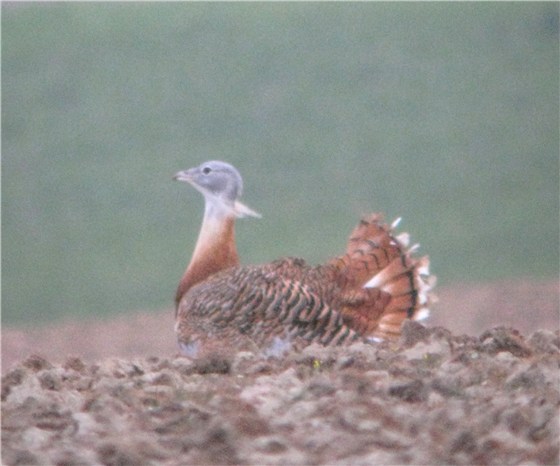
Great Bustard - an even bigger target bird!
We crept away leaving the Great Bustards undisturbed to carry on their weird displays. Suddenly, one, then two more, Black-bellied Sandgrouse hurtled across the sky like some jet-propelled chickens that were late for a very important date. We made our way back to the car serenaded all the way by larks and seeing more Little Bustards while Corn Buntings jangled their songs from every fence wire. What a wonderful place.
We shivered in the car until the heater kicked in and we slowly thawed out. That wind had been cruel, but what a stunning experience to be out at dawn in this spectacular landscape. A short drive north brought us to the brow of a small hill and gave us a commanding view across the rolling grasslands. We parked and scanned from the car. A fine male Montagu’s Harrier drifted past like a child’s balsawood model. It looked so light and graceful, the black markings on the wing-tips forming a wedge, a grey body with barred tail. What a beauty. Then we heard a call. At first it was distant and hard to make out, then clearer: “Gawk, Gawk”. Sandgrouse! Pintailed Sandgrouse this time, and we needed to see them. We scanned the vast sky. The calls came again, closer now and more of them. Panic! Where are they? Then they were right above us. Perhaps forty of these scarce nomadic birds swept across the sky at high speed. We willed them to turn and they did! They circled twice, all the time calling loudly and catching the faint early morning sun as they banked first one way then the other. Sadly, they didn’t land in view but what an encounter, magic stuff and we were left breathless and elated. The Sandgrouse family is one of our favourites, and we had just seen two species in less than an hour.
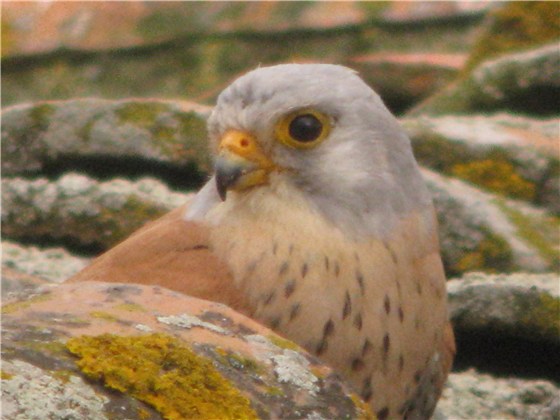
Lesser Kestrel, happy to share its roof with the starlings!
This extract can give you only a taster of just how amazing the birdwatching is in beautiful Extremadura. We still have space on our trip to this bird-rich part of Spain in March 2013, so if you're tempted by the sound of fantastic birding in stunning landscapes, do come and join us!
Email us on
info@thebiggesttwitch.com for more information or to book your place on this exciting birdwatching trip to Extremadura. We look forward to hearing from you!